21.5-inch iMac (Late 2013) Review: Iris Pro Driving an Accurate Display
by Anand Lal Shimpi on October 7, 2013 3:28 AM ESTThe Display
When it was first announced, I shrugged off the 21.5-inch iMac model. At the time I was using a 27-inch Thunderbolt Display and couldn’t see myself using anything smaller, or lower resolution. With the new 27-inch iMac looking a lot like last year’s model with evolutionary upgrades on the internals, I was obviously drawn to the new 21.5-inch system because of its use of Intel’s Iris Pro 5200 graphics so I ended up with the first < 3MP desktop display I’d used since the release of the first 30-inch 2560 x 1600 panels years ago.
Given how much time I spend on notebook displays these days, now was as good a time as any to go back to a 1080p desktop display. While I’d prefer something with an insanely higher resolution, it’s still too early for a 21.5-inch 4K panel (or a 27-inch 5K panel), which Apple would likely move to in order to bring Retina displays to its desktops.
There are two reasons why you’d opt for the 21.5-inch iMac vs. the larger one: cost and size. At a bare minimum you’re looking at a $500 price difference between the 21.5 and 27-inch iMacs, which is pretty substantial to begin with. The size argument is just as easy to understand. The 27-inch iMac occupies a considerable amount of space on my desk, and I’ve come to realize that not everyone likes to be surrounded by a sea of desks. Either way there’s clearly a market for a computer this size, with this sort of a resolution. So how does the display fare?
In short: it’s nearly perfect.
Brian and I were comparing notes on the two reviews we’re working on at the same time. He sent me some CIE diagrams showing me color accuracy for the displays he’s testing, I responded with this:

21.5-inch iMac (Late 2013) Saturations
Those boxes show what’s expected, the circles inside of them show what’s delivered by the display. The 21.5-inch iMac is spot on, out of the box, without any calibration required. Brian’s response:
WOW
is that out of the box?
The iMac’s display does extremely well in all of our tests, always turning in a delta E of less than 2. It’s just incredible. I'm borrowing the graphs below from our tablet bench data, but I've tossed in the 2013 MacBook Air as a reference point.

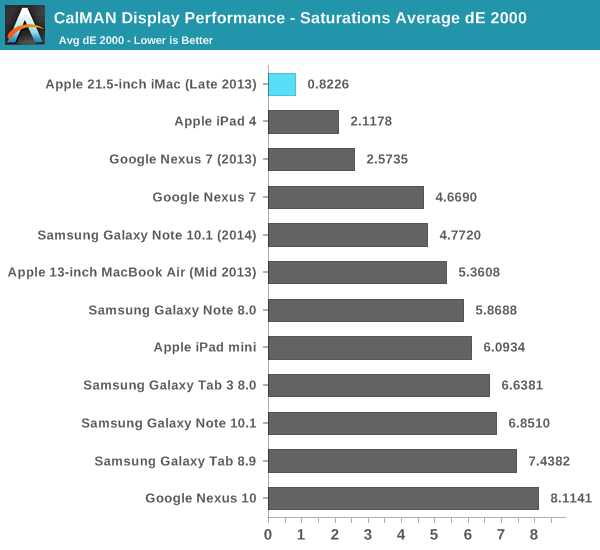
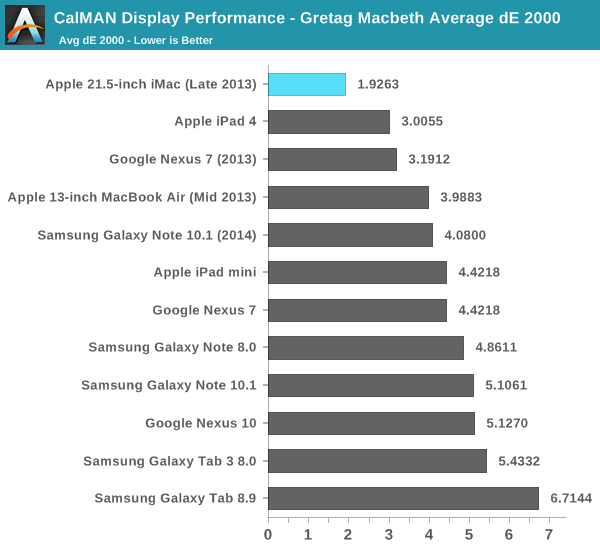

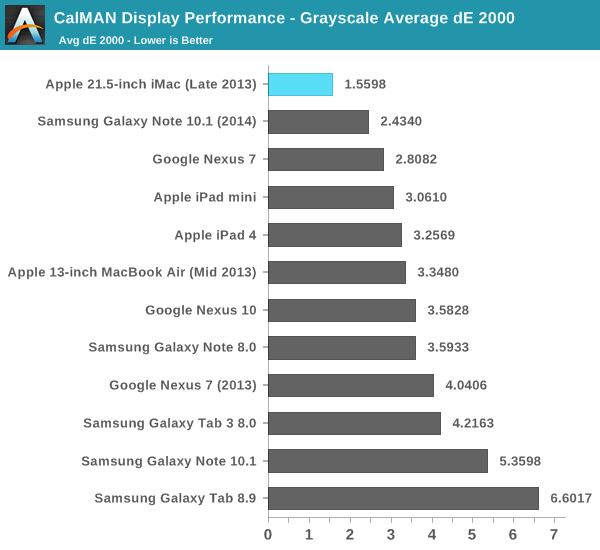
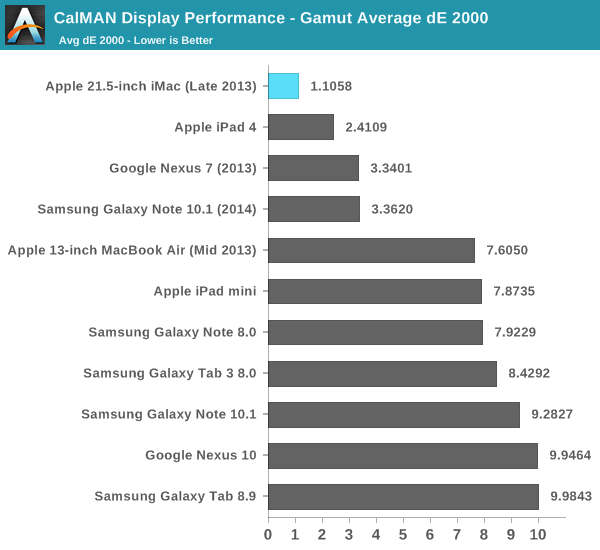

Although I doubt Apple’s intended audience for the entry-level 21.5-inch iMac are imaging professionals, they could very well use the system and be perfectly happy with it. Literally all that’s missing is a 2x resolution model, but my guess is it’ll be another year before we see that.
I have to point out that Apple does source its display panels from multiple providers (typically 2 or 3), not to mention panel variance within a lot. I don’t anticipate finding many panels better than the one in my review sample, but it’s always possible that there will be worse examples in the market. I haven’t seen huge variance in color accuracy from Apple panels, so I think it’s a pretty safe bet that what you’re going to get with any new iMac is going to be awesome.



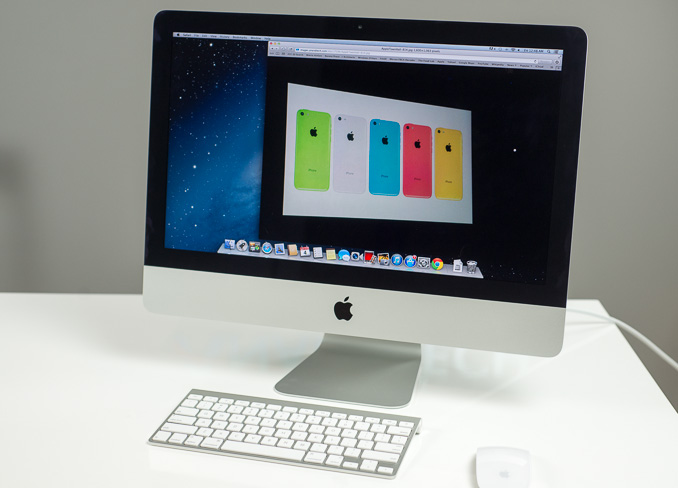











127 Comments
View All Comments
foolio5 - Monday, October 14, 2013 - link
Sammy 840 EVO 128 GB SSD is $99 bucks and up there in the speed/longevity department.akdj - Tuesday, October 15, 2013 - link
Sammy 840 will read about half the speed of the new PCIe SSD in the 2013 iMac. It'll be at least twice as quick. These aren't 2.5" SATA3 drives. They're PCIe. Big difference. Small price to pay for the upgrade. You'll never know you don't have a 1.15 TB SSD in there for most consumer workflows. They. Flat. Fly. It's a bargain. That said, I'm with you on the RAM. $100 for 16 seems fair and nicely set for three-five years. While still being able to sell it for 50% after a half decade :-)djscrew - Monday, October 7, 2013 - link
putting a hard drive in, even at a base level, should be considered a crime to computing in this day and age... a 256 gb ssd should be stock... for a company that pushes quality and doesn't concern itself as much with price, apple should have ditched the hdd this generationsaarek - Tuesday, October 8, 2013 - link
256GB is not enough memory for a large proportion of computer users, a more realistic and useful answer would have been for Apple to have made the 1TB Fusion drive the default option.iwod - Monday, October 7, 2013 - link
I Hope Apple can cut cost in their next model some where and put in SSD as Default.idget - Tuesday, October 8, 2013 - link
Personally I prefer the design of the '09 models. Sure it doesn't look "pretty" as these ones (subjective), but I feel that on the imacs, Apple's "thin is good" mentality is annoying.The "bulge" at the back looks ugly. Also because it's so thin, everything is moved to the back, including the sd card slot, which I feel is better on the side of the computer. It's a pain having to reach around the computer (especially on the 27inch). Also it needs more usb ports
I feel that Apple has gone for looks and forgot function on these imacs
alpha754293 - Tuesday, October 8, 2013 - link
How much power does it consume at full load and at idle?MF2013 - Tuesday, October 8, 2013 - link
I'm not sure if the graphics comparison to the DDR3 version of the GT 750m is fair. The DDR3 cripples the graphics performance, and while I don't know what the sales volume numbers are, my impression is that most 750m's that ship do so with DDR5. Also, anybody who games and cares about GPU performance, and is the least bit informed, would make sure to get the DDR5 version. And it's not like the DDR5 version is expensive- the Lenovo y500's that occasionally go for sale around $830 have 2GB of DDR5.So all this demonstrates is that Iris Pro graphics can compete with bandwidth crippled discrete graphics. But if you don't care about gaming, you shouldn't care about whether the integrated graphics are competitive with discrete GPUs. And if you do care about gaming, this performance is still not good enough. The positive tone of this review doesn't seem justified.
speculatrix - Tuesday, October 8, 2013 - link
I just hope you never have to have it repaired out of warranty.mschira - Tuesday, October 8, 2013 - link
nice review, and interesting to see that with Crystallwell there is an integrated GPU that does have acceptable performance.Will be interesting to see in a 13" MBR.
What would also be interesting are performance comparisons of the new real GPUs if and how much better they are than the 2012 level.
GPU performance is still a bottleneck for iMacs I think (i.e. gaming).
M.